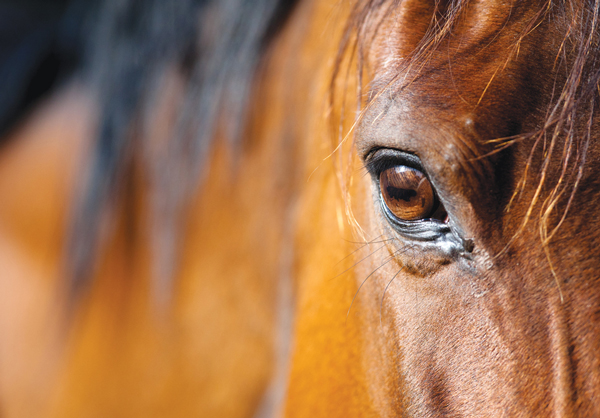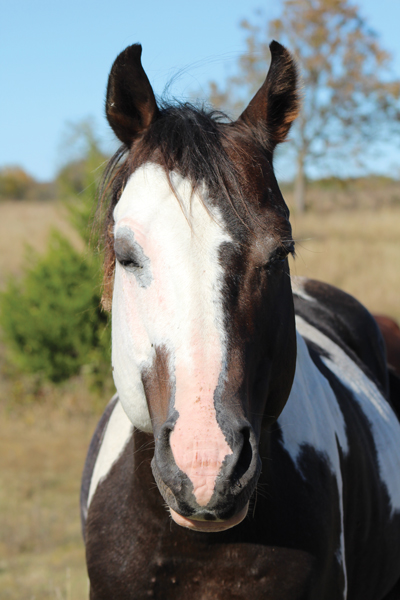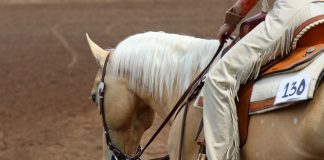
Despite their reactive reputation, horses are not always easy to read—particularly when they are well-trained. Ol’ Fred may seem calm and cool on the outside, but inside he may be shaking in his horseshoes. A recent study out of the University of Guelph asserts that there is a non-invasive method to assess stress in horses, and it involves the smallest of movements: blinking.
The spontaneous blink, which is not something a horse does purposefully, nor is it something a horse would need to be “trained out of,” neatly fills that gap. Variations on the blink, such as half-blinking and upper eyelid twitching, were also tallied, as they too have been shown to change relative to emotional stimuli.
How It Was Done
The study looked at 33 horses from three different riding stables in Ontario, Canada. All of the horses were lesson horses ranging in age from 5 to 17 years old. In general, well-seasoned lesson horses have been exposed to a wide variety of circumstances and are trained to be cooperative. The researchers wanted to make sure they were able to find a marker of stress, particularly in compliant horses.

There were four components of the study: control, feed restriction, separation, and a startle test. During all of the tests, the horse’s heart rate was recorded, as were any obvious behavioral signs of duress. A video camera recorded eyelid movement.
Except for the food restriction portion, the tests were done during quiet times at the stable when lessons and feeding did not normally occur. Each horse had the same handler and observer for all of the tests, and each test lasted three minutes.
◆ During the control segment, each horse was observed in his regular turnout area with visual access to his stall mates while baseline heart rate and eye-blink rate were taken.
◆ The feed restriction test occurred during normal afternoon lunchtime. Instead of being fed, the test horse was tied in the stall within view of the other horses while they enjoyed their meal.
◆ The separation test took place in a testing arena where the other horses were out of sight but still within earshot.
◆ Researchers performed the startle test in a distant arena where there was no visual access to other horses. There, they threw a ball at a 6-foot distance from each horse and monitored his reaction.
Does the amount of horse blinks indicate stress?
Human studies have found that mentally stressful situations tend to increase blink rate, while visually stimulating tests, such as complicated computer games, decrease blink-rate.
A decreased blink rate is often associated with focused attention and likely allows the participant the advantage of gaining maximum visual information.
Based on this knowledge, the team predicted that spontaneous blink rates would increase during the food restriction and separation tests and decrease during the startle test.
After all the horses were tested, however, a different picture emerged. Each test resulted in a decrease in blinks. While the control segment resulted in about eight to nine blinks per minute, blinks dropped to about five per minute during each of the tests.

The food restriction test proved the most stressful for the horses, and the most revealing for the researchers. When deprived of their lunch, the horses showed an elevated heart rate and definite signs of agitation, such as increased mouthing and restlessness.
Like the other tests, the eye-blink rate was around five per minute. However, the norm of two eye twitches per minute during the control and other tests jumped to six per minute. This was the only test in which eye twitches were noticeably more prevalent.
The separation test and the startle test had similar results: no increase in heart rate and no show of nervousness, but full blinks and half-blinks occurred less often.
These results could be confounding, but the researchers concluded that a decreased blink rate without an increase in eye twitches may indicate a more curious or interested emotional state—one in which the horse is neurologically tuned in.
A Closer Look
The results were clear to the researchers. Of the three tests, food restriction stood out as a glaring stressor. The combination of increased eye twitches and a decreased blink rate held a powerful, though subtle, message—one that an observant handler could potentially learn to read and understand.
This research beckons us to remember that the highly trained horse has learned to contain his natural fight or flight tendencies; however, a thoughtful handler may find insight by simply taking a closer look.
This article about if a horse’s blinking could indicate stress appeared in the August 2020 issue of Horse Illustrated magazine. Click here to subscribe!





